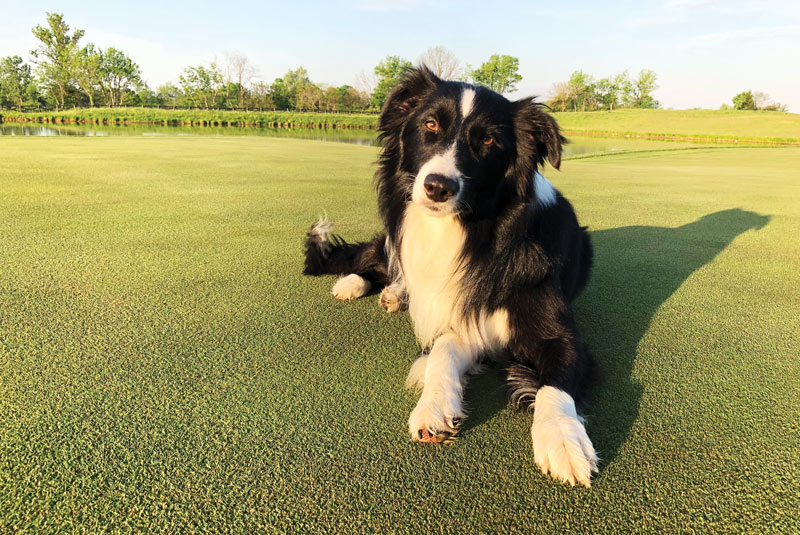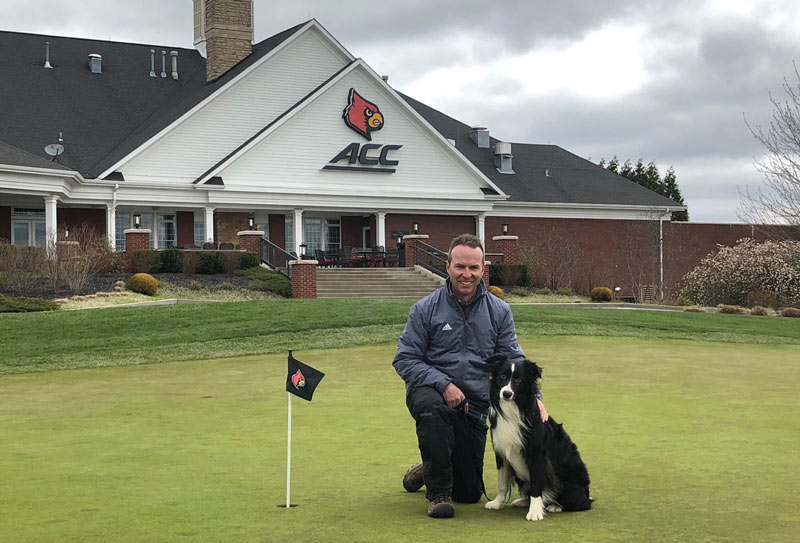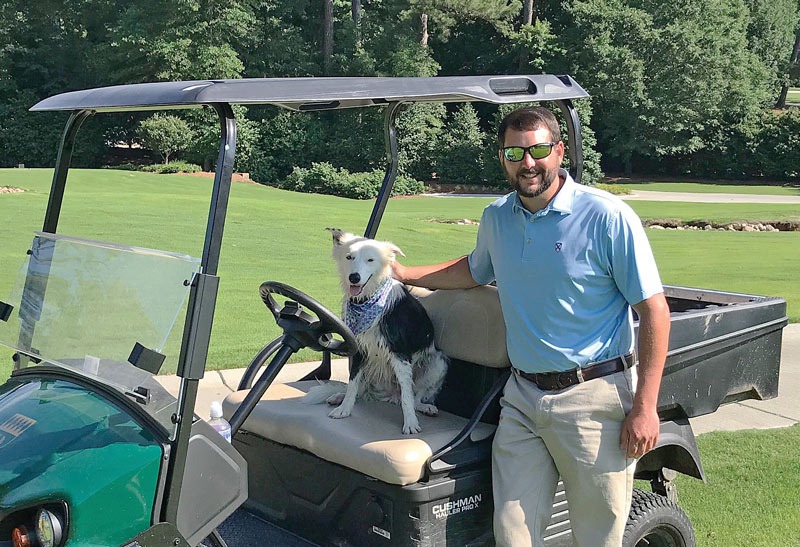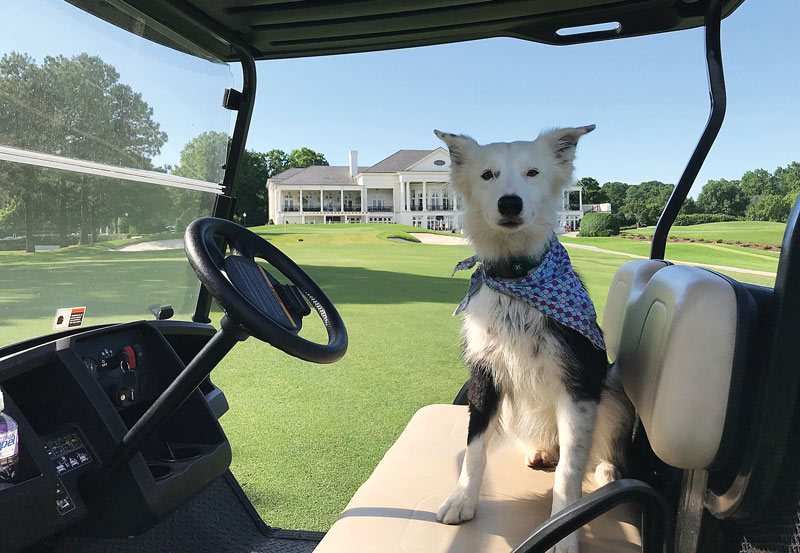
Meet Jack, the border collie won by John Ballard, CGCS, who oversees the University of Louisville Golf Club. Jack has been on geese patrol at the facility since May. Photo courtesy of John Ballard
Welcome home, Jack and Storm.
The two border collies are in different places but on similar missions. Nearly 1,000 people registered to win the dogs in February during the Golf Industry Show in San Antonio, a giveaway made possible by a partnership between LebanonTurf and GCMOnline.com. The lucky winners? John Ballard, CGCS, and Scott Steiner.
Contest organizer Flyaway Geese has trained more than 250 border collies that now roam golf courses. The dogs’ purpose? Effectively and humanely eliminate the nuisance created by geese and other wildlife. The dogs operate not only on golf courses but at colleges and universities, private estates, assisted living communities, and elsewhere.
Rebecca Gibson, owner of Flyaway Geese since it launched in 1997, prepared Jack and Storm — both are just over 18 months old — for their new residences. She delivered the dogs this spring to their respective homes, and provided their new handlers with a 19-page manual to inform them on commands, obedience, diet and more for border collies, whose life expectancy is 14 to 16 years. Before a new handler puts a dog to work, dog and handler share a bonding period that’s about two weeks long. Gibson says she occasionally has to train the handler to be patient.
“It’s like I have brought them a Christmas present that they can’t open for two weeks,” Gibson says. “It also is like having a new employee — you teach them how to do things before they can do everything. They (handlers) just can’t stand it. They want to work the dog so bad. It is really important to understand how to handle a dog correctly. We spent 20 years learning how best to do it.”
Gibson, a certified wildlife damage control agent for the state of North Carolina, does her homework too. Finding the right environment for each dog is critical, which is why she asks prospective owners to complete a questionnaire. Questions include whether they have children at home and whether it’s important to have a dog that swims. “It’s almost like a matchmaking service,” she says.
It appears Jack and Storm have each met their match.
Jack and ’Ville
John Ballard, CGCS, fires up his John Deere 825i Gator. Jack the border collie is fired up too.
“I get the speedometer going to 30 mph, and he can keep up running along the side of me. That’s pretty impressive,” says Ballard, who oversees the University of Louisville Golf Club in Kentucky.
A 23-year GCSAA member, Ballard says adding a border collie to his operation wasn’t necessarily on his radar, although he does have two large bodies of water on the property that attract geese. He attended one of the demonstrations that Gibson orchestrated at GIS, threw his name into the contest, and then went on his way to partake in show events. Later that day, Ballard began receiving calls, texts and handshakes of congratulations, including in-person best wishes from GCSAA’s director of chapter outreach, Steve Randall. That’s how he learned he’d won a border collie.
Generally, it takes about 30 days before a dog is settled into its new home and is confident in its handler (Gibson spends a day with the handler when she delivers a dog). In her manual, Gibson states that lack of confidence in its handler can cause a dog to be uncomfortable. Ultimately, the dog’s job is to make the birds leave, and the dog isn’t done until all the birds are gone. The only reward they need, Gibson says in the manual, is “lots of praise and more birds to chase.”

Superintendent John Ballard, CGCS, with Jack. “When you give him a command or call his name, he cocks his head. You can tell the wheels are spinning,” Ballard says. Photo courtesy of John Ballard
So far, Jack has proved to be well-mannered and good-tempered, and he gets along very well with Ballard’s chocolate Labrador retriever, Bela, who served as geese chaser before Jack came aboard. Loud honking signals the arrival of geese, with their long, black necks, white-patched faces and plump bodies. “Bela does chase and is a pretty good swimmer,” Ballard says, “but what I learned through Rebecca is geese never feel threatened by Bela. They’re annoyed by her, but will come back. Jack has a wolf-like mentality. Geese are threatened by his demeanor. He keeps his tail down, crouches down, when he stalks them.”
The University of Louisville Golf Club has two fairways that border water — areas that “are a mess” with geese defecation. Ballard had tried numerous strategies (from laser beams to the Bird Banger) to eliminate the geese issue at the club and at another course he previously worked at in the area, but those efforts didn’t last.
So far, Jack has made an impact, and proper training has been imperative to his success. According to Gibson, border collies want to work, not harm geese or other wildlife. “Keeping the dog’s obedience crisp is so important. If that falls by the wayside and the birds come back, the dog may not have the obedience it had before,” Gibson says.
Jack acts like himself whether he’s dealing with geese or members of Ballard’s crew. “The nature of border collies is herding. You can see that, even when he’s walking around people,” Ballard says.
A key to Jack’s adjustment has been a daily regimen. “Rebecca said to exercise him with commands 10 minutes each day. It’s like a 5-mile run,” Ballard says. “He is a very calm dog. Listens very well. When you give him a command or call his name, he cocks his head. You can tell the wheels are spinning.”
Ballard has received questions from other golf course superintendents about Jack, and has even taken him to see superintendent Roger Meier a couple of times at Valhalla Golf Club in Louisville, an Audubon-certified facility that has hosted multiple PGA Championships and the Ryder Cup. Meier, a 22-year GCSAA member, says he’s a bit envious of Ballard now that he has witnessed Jack in action.
“Jack is very impressive with instruction and is very attentive to John. It is amazing to watch how these dogs work and respond to commands,” Meier says. “Their agility and energy is amazing.”
At home, Jack has bonded with Ballard’s sons, Grant and Nicholas. At work, he loves being in his crate when he’s not on the course. “He sheds a dog a day, and he can jump like nobody’s business,” Ballard says.
Jack also has quite a fan base. “When John comes up here, we don’t ask him how he is doing. We ask how Jack is doing,” says Sam Robey, director of marketing and membership at the club (who adds that they actually do ask how John is doing — after they have received a Jack update). “Jack has been a great addition to our Cardinals’ family. We have done some things with him for social media. Now everybody here is asking for him to have his own social media account. I’ve taken lots of pictures of him. He loves smiling for the camera. I’m a dog lover, so I’m happy he is here. I still ooh and aah over him.”
Obviously, so far, so good for Jack in Louisville. “Just a good dog that is nice to have around,” Ballard says.
Taking Carolina Country Club by Storm
Kyle Johnson got his wish.
“He had been saying for a while that he wanted a dog for the golf course,” says Scott Steiner, senior assistant superintendent at Carolina Country Club in Raleigh, N.C. No wonder, then, that Johnson, GCSAA Class A director of golf course maintenance, was ecstatic when he and Steiner entered the border collie contest at GIS and emerged victorious. “We’re both pretty excited about it, to say the least,” Steiner says.

Kyle Johnson, director of golf course maintenance at Carolina Country Club in Raleigh, N.C., with border collie Storm. “When she gets up in the morning, she’s ready to go straight to work,” Johnson says. Photo courtesy of Kyle Johnson
Johnson, a 10-year association member, was beaming. “I didn’t have any reservations about it. I couldn’t wait to get her and let her go nuts,” he says of border collie Storm. “Her first time off the leash was a little skittish, but after 20 minutes, when she realized that she could go, she went — really fast.”
A couple dozen geese regularly visit Carolina CC. Fall is the worst time of the year for them, Steiner says. The 11th hole features an island green of Champion bermudagrass, a popular spot for geese to collect and cause problems. “They make their mess there, pooping. They pick at some of the turf. I’m not sure what they’re trying to get,” says Steiner, a seven-year association member. “They are away from people there, so cleanup can be difficult. It takes quite a while to blow off the green. Sometimes we wash it off with a hose.”
Until Storm appeared, Steiner’s Golden Retriever, Esso, roamed the course. “Esso is great. Geese tick him off sometimes, but (he) doesn’t have the mind that is trained to do the work. With Storm, you can tell that her brain is always working,” says Steiner, noting that Storm doesn’t bark much. “Storm and Esso play together, chase geese together, have a good time. It’s a treat to watch Storm work.”
Storm has invigorated the crew at Carolina CC. “She’s been a morale booster. She seems to put a smile on peoples’ faces,” says Steiner. Storm also possesses characteristics that ... well, if you have a dog, you’ll understand where Steiner is going with this. “She rolls around in stuff she shouldn’t be rolling around in,” he says.
Johnson houses Storm, who has a favorite at home. “It’s my 2-year-old daughter, Chandler. Storm loves that little girl,” Johnson says. Storm is a bundle of energy when she reports to work, even though she isn’t fed (4 cups of high-protein lamb and rice) until evening. The later feeding time helps the dog avoid cramps at work.

A dog’s day: Storm on the job at Carolina Country Club in Raleigh, N.C. Photo courtesy of Kyle Johnson
“When she gets up in the morning, she’s ready to go straight to work,” Johnson says. “It’s like a 100-acre playground to her. When we get there, she runs beside my cart, three laps around, before she gets in. She’s wound up in the morning. Has she helped? Absolutely. She’s become somewhat of a celebrity at our club, been embraced so well. She’s like a mascot. She has a loving demeanor. You appreciate her and don’t feel threatened by her by any means. I always wanted a dog to take to the course every day.”
Storm may even have her own dog blog someday, Johnson says. Already, though, she has made quite a statement. “Most dogs are just pets. These dogs have a purpose. And they have a job to do,” Steiner says. “She has proven that she can bounce back after a long day. There’s not many places where you can bring your dog to work. These dogs definitely have a place at the golf course.”
Howard Richman is GCM’s associate editor.